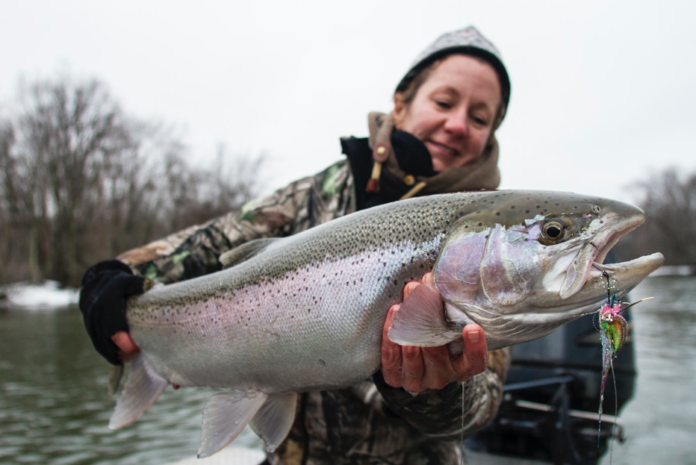Written by: Chuck Hawkins, Hawkins Outfitters
These five patterns will help you fish through the three-stage early season.
Photo by Chuck Hawkins
Most fly anglers eagerly await the start of the spring steelhead run. Here what I believe are the top five spring steelhead flies and when to use them. Any list of the top five steelhead flies for spring or for anytime has to include the Clown Egg. Steelhead love them! That list should also include our Rabbit Wiggle Nymph, a Black Stone, Ed’s Salmon Alevin, and Kevin Feenstra’s Shrew.
Just as important as carrying the right patterns is understanding the spring run and when to fish these flies. The spring run should be broken down into three distinct segments: pre-runoff, during runoff, and post-runoff. The substantial variation in both water flows and water temperatures requires the fly angler to vary the patterns to meet these challenges.
Pre-Runoff
Before runoff begins, the water is usually low, clear, and cold. The number one fly during these times is the Clown Egg, and the colors need to differ in different conditions. There is no perfect color that is king all season long. In cold water during winter and early spring, combinations of pinks and oranges usually outperform other combos. Just as important as color is size, and in cold water I like my eggs to be no larger than a dime.
During Runoff
Another great fly to use this time of year is Ed’s Salmon Alevin. Dead-drifted or swung, this little bug attracts a lot of attention. As the snow pack melts and the rivers increase their water volume, they generally become much more turbid. This requires changes in patterns, color, and size. First we need to revisit the Clown Egg. Brighter colors and much larger sizes are now in order. Chartreuse, oranges, bright yellows all have a place in these eggs, which are now the size of a quarter or more. Fish have to see them to eat them! When we have these water conditions, we go deeper into my list, and this is when the Black Stone and the Rabbit Wiggle Nymph come into their own. Black Stones begin to hatch in spring, with lots of them moving around the bottom. Tie them large enough to be seen, and they will get eaten.
Post-Runoff
As the spawn hits full swing and the drop-backs (steelhead returning to the lakes) are on the move, it’s time change again! The Clown Egg is still strong, but size reduces back to the dime and colors change. More muted colors similar to the natural eggs will get response. Jon Ray’s Lemon Parade Clown Egg is a player this time in the year. Also our Alevin pattern can be taken as a caddis larva. When steelhead grind rocks to spawn, they dislodge a lot of these insects.
Drop-back steelhead revert to their trout-like tendencies, and they will eat streamers on tight line presentations. The final fly of the top five is Kevin Feenstra’s Shrew, an ideal swing pattern for hunting drop-back steelhead. With the number of gobies, sculpins, and chubs in the river during the spring, this fly matches the hatch.
Carry these top five steelhead patterns in a variety of colors and sizes, so you can adjust to changing water conditions. Fished in the correct manner, in the right places, these flies will produce results.
Chuck Hawkins owns and operates Hawkins Outfitters, in Lake Ann, Michigan.
Credit: Source link































